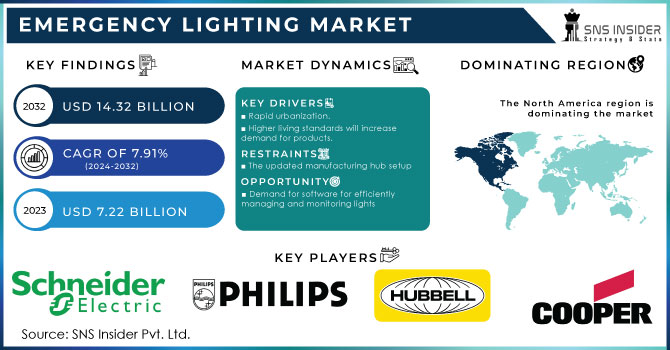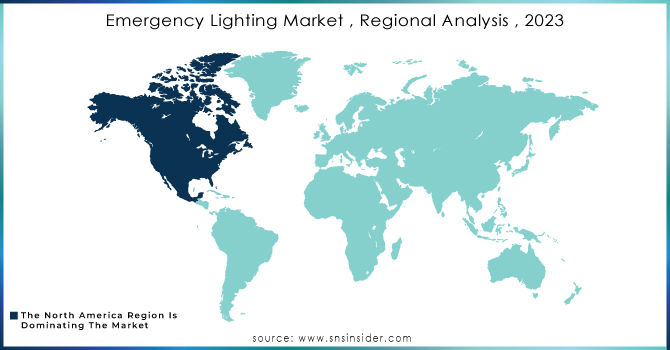Emergency Lighting Market Report Scope & Overview:

Get more information on Emergency Lighting Market - Request Sample Report
The Emergency Lighting Market size was valued at USD 7.22 billion in 2023 and is expected to grow to USD 14.32 billion by 2032 with a growing CAGR of 7.91% over the forecast period of 2024-2032.
Emergency lighting's role during a mains power loss is to illuminate the escape path to a level that makes it safe for building occupants to depart. The Australian Building Code states that emergency lighting systems are required in all types of structures, with the exception of remote single-family houses and non-habitable projects. When a facility has a power loss or when a lighting circuit malfunctions, emergency lighting is described as a battery-operated lighting system that instantly turns on. When the regular lighting system is incapacitated due to situations like earthquakes, fires, terrorist attacks, sabotage, or power outages, emergency lighting is a sort of auxiliary lighting that turns on right away, independently of a generator system. Systems for emergency lighting make it possible for individuals to leave a facility safely. Emergency lighting systems' primary goal is to avoid fatalities by enabling safe escape.
By designating obvious departure routes that save people from running into barriers, getting hurt, panicking, or forming enormous groups, they assist in the quick and safe evacuation of individuals from buildings. Emergency lighting systems can assist to avoid accidents in hazardous workplaces by making fire alarms, fire extinguishers, and first-aid kits easily visible.
MARKET DYNAMICS
KEY DRIVERS:
-
Rapid urbanization.
-
Higher living standards will increase demand for products.
Improved living conditions and rapid urbanisation in different nations are also anticipated to promote market expansion and generate enormous demand. Also, increasing home building is increasing the need for emergency lighting in apps for private use. For instance, depending on application, the residential category represented the highest size in the sector in 2020. This is a result of the Middle East and Africa (MEA) and Asia Pacific areas seeing an increase in residential development and flat construction. Also, the aircraft industry's growing use of lighting systems.
RESTRAIN:
-
The updated manufacturing hub setup
OPPORTUNITY:
-
Demand for software for efficiently managing and monitoring lights
CHALLENGES:
-
Design-related problems that may reduce a building's aesthetic attractiveness include
-
Difficulties in establishing new manufacturing hubs.
Manufacturers and investors confront difficulties in a number of nations, mostly as a result of stringent government policies, such as laws and regulations relating to environmental measures. Furthermore, it is necessary to gather pertinent data from a drawing or a site assessment before beginning any emergency lighting design since failing to do so might lead to an inadequate emergency lighting design system. These elements are limiting market share in developing nations.
IMPACT OF RUSSIA-UKRAINE WAR
The present war between Russia and Ukraine, as well as the sanctions and other penalties that have been placed on Russia as a result, are seriously causing instability in the world economy. We are unable to foresee the effects that these actions will have on the global economy or on our financial situation, results of operations, and cash flows as of the date of these financial statements, despite the fact that we do not have operations in Russia or Ukraine and do not have a significant amount of direct exposure to clients and suppliers in those nations.
For the fiscal year that concluded on August 31, 2022, net sales of $4.01 billion climbed by $545.1 million, or 15.7%, over the corresponding period in the previous year. Recent price hikes and larger volumes helped both our ABL and ISG divisions. Compared to the preceding year, net sales increased by around 3%, with revenues from acquired firms playing a part. The net sales for the fiscal year that concluded on August 31, 2022, were not significantly impacted by changes in foreign exchange rates.
IMPACT OF ONGOING RECESSION
The global economy grew rapidly in 2021, primarily as a consequence of the base effect from the recession brought on by the COVID-19 epidemic in 2020. Significant economic recovery -has resulted from the economic openness observed in 2021, notwithstanding the COVID-19. Worldwide supply constraints and pandemics continue. Oxford Economics projects that the real-world GDP will have increased by 5.8% in 2021 as opposed to the -3.5% predicted in 2020. According to estimates for Philips' markets, Latin America, Europe, and Japan have not yet attained real GDP levels comparable to those of 2019. According to Oxford Economics, the real GDP growth rate will slow to 4.2% in 2022.
KEY MARKET SEGMENTATION
By Power System
-
Self-Contained
-
Central
-
Hybrid
By Battery Type
-
Ni-Cd
-
Ni-MH
-
LiFePO4
-
Lead-Acid
By Light Source
-
Fluorescent
-
LED
-
Incandescent
-
Induction
-
Others (High Intensity Discharge, Cold Cathode, Halogen Lamps)
By Offering
-
Hardware
-
Software
-
Services
By Application
-
Residential
-
Commercial
-
Industrial
-
Others (Railways, Aircraft, Ships)
REGIONAL ANALYSIS
North America is dominating the market. North America still has a disproportionate amount of the market share, APAC is predicted to see the fastest growth throughout the projection period. The greatest market share in North America is due to developments in the lighting industry's technology and rising safety consciousness. The market in APAC is expanding as a result of the rising use of emergency lighting in emerging nations like China and India.
China now owns the greatest market share in the Asia Pacific area, due to the existence of several significant suppliers. In recent years, China has transformed into a significant exporter of goods to other nations. The regional market is expanding as a result of the expanding population.
Europe is anticipated to expand with the advent of new technologies like intelligent systems and human centric systems. For instance, the European Commission announced new eco-design guidelines for business in December 2019 in order to provide customers with energy-efficient products. Also, the development of smart cities is stimulating the LED business in the area. Demand for software for efficiently managing and monitoring lights worldwide is anticipated to present profitable opportunities.

Get Customized Report as per your Business Requirement - Request For Customized Report
REGIONAL COVERAGE:
North America
-
US
-
Canada
-
Mexico
Europe
-
Eastern Europe
-
Poland
-
Romania
-
Hungary
-
Turkey
-
Rest of Eastern Europe
-
-
Western Europe
-
Germany
-
France
-
UK
-
Italy
-
Spain
-
Netherlands
-
Switzerland
-
Austria
-
Rest of Western Europe
-
Asia Pacific
-
China
-
India
-
Japan
-
South Korea
-
Vietnam
-
Singapore
-
Australia
-
Rest of Asia Pacific
Middle East & Africa
-
Middle East
-
UAE
-
Egypt
-
Saudi Arabia
-
Qatar
-
Rest of Middle East
-
-
Africa
-
Nigeria
-
South Africa
-
Rest of Africa
-
Latin America
-
Brazil
-
Argentina
-
Colombia
-
Rest of Latin America
RECENT DEVELOPMENTS
-
November 2021: Schneider Electric has taken home the 'Outstanding Contribution to Sustainability and Efficiency' award from the DCS Awards. For the category of "Sustainability in the Data Centre Project of the Year," Schneider Electric and Elite Partners Advanced Power Technology won a second special project award at the event.As part of a larger digital transformation strategy, the firms worked together to modernise Newcastle City Council utilising energy-efficient technology to minimise its carbon impact.
-
The Zero Carbon Project was introduced in April 2021 by Schneider Electric, a pioneer in the digital transformation of energy management and automation. As part of the new plan, the business will collaborate with its top 1,000 suppliers, who are responsible for 70% of Schneider's carbon emissions, to reduce their operations' carbon emissions by 50%.
-
The Schneider's Sustainable Development Goals for 2021–2025 include the programme. It is a tangible step towards the Paris Agreement's goal of keeping the rise in average global temperature to 1.5°C or less by 2100.
-
In February 2021, Honeywell paid USD 1,303 million to buy all of Sparta Systems' outstanding shares. It is anticipated that Sparta Systems will further solidify its position in enterprise performance management software, digital transformation solutions, and industrial automation. This company is a part of the Performance Materials and Technologies division.
KEY PLAYERS
The Major Players are Philips Lighting holding B.V. (Netherlands), Hubbell Lighting Inc. (US), Cooper Industries (Ireland), Schneider Electric SE (France), Emerson (US), Legrand S.A. (France), Acuity Brands (US), Beghelli S.p.A. (Italy), Daisalux (Spain), Zumtobel Group (Austria), OSRAM Licht AG (Germany), Digital Lumens (US), Fulham Co. Inc. (US), Arrow Emergency Lighting Limited (Ireland), Arts Energy (France), Taurac (US), and other players are listed in a final report.
| Report Attributes | Details |
|---|---|
| Market Size in 2023 | USD 7.22 Bn |
| Market Size by 2032 | USD 14.32 Bn |
| CAGR | CAGR of 7.91% From 2024 to 2032 |
| Base Year | 2023 |
| Forecast Period | 2024-2032 |
| Historical Data | 2020-2022 |
| Report Scope & Coverage | Market Size, Segments Analysis, Competitive Landscape, Regional Analysis, DROC & SWOT Analysis, Forecast Outlook |
| Key Segments | • By Power System (Self-Contained, Central, Hybrid) • By Battery Type (Ni-Cd, Ni-MH, LiFePO4, Lead-Acid) • By Light Source (Fluorescent, LED, Incandescent, Induction, Others) • By Offering (Hardware, Software, Services) • By Application (Residential, Commercial, Industrial, Others) |
| Regional Analysis/Coverage | North America (US, Canada, Mexico), Europe (Eastern Europe [Poland, Romania, Hungary, Turkey, Rest of Eastern Europe] Western Europe] Germany, France, UK, Italy, Spain, Netherlands, Switzerland, Austria, Rest of Western Europe]), Asia Pacific (China, India, Japan, South Korea, Vietnam, Singapore, Australia, Rest of Asia Pacific), Middle East & Africa (Middle East [UAE, Egypt, Saudi Arabia, Qatar, Rest of Middle East], Africa [Nigeria, South Africa, Rest of Africa], Latin America (Brazil, Argentina, Colombia Rest of Latin America) |
| Company Profiles | Philips Lighting holding B.V., Hubbell Lighting Inc., Cooper Industries, Schneider Electric SE, Emerson, Legrand S.A., Acuity Brands, Beghelli S.p.A., Daisalux, Zumtobel Group, OSRAM Licht AG, Digital Lumens, Fulham Co. Inc., Arrow Emergency Lighting Limited, Arts Energy, Taurac |
| Key Drivers | • Rapid urbanization. • Higher living standards will increase demand for products. |
| Market Opportunities | • Demand for software for efficiently managing and monitoring lights |

